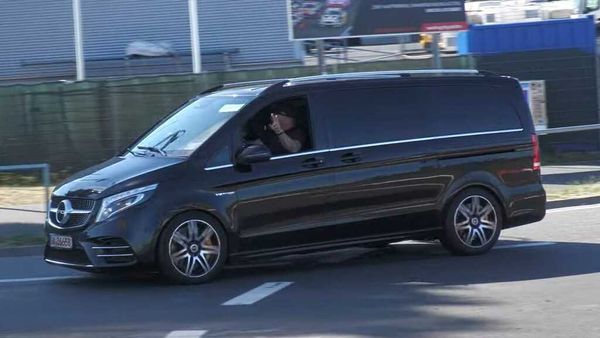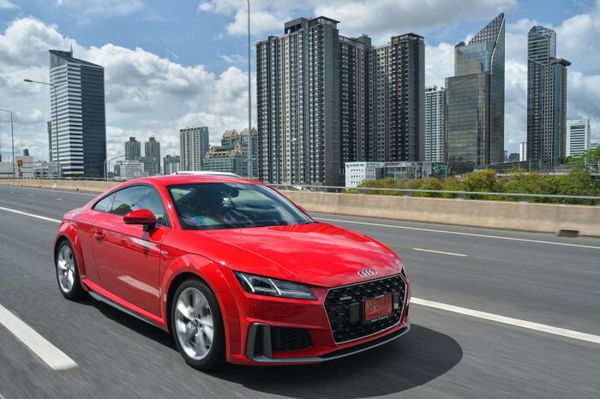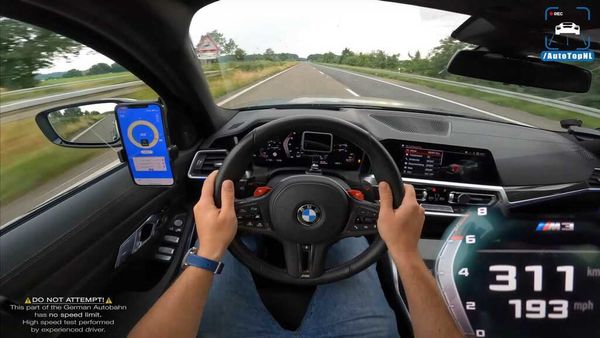When it finally arrived in the United States as a 2021 model, the Audi RS6 Avant was the first admission from the automaker that we could finally be trusted with one of its most desirable products. Yes, Americans had experienced the RS6 before, but only as a sedan and only for the 2003 model year. Even after lots of anticipation, the twin-turbocharged station wagon wearing those four interlocking rings somehow lived up to the hype.
Audi is celebrating the model’s 20th anniversary this year – it debuted in some global markets in 2002 – and the automaker arranged for every generation of Avant, as well as a lone second-generation sedan, to meet up in the scenic Canadian city of Banff, Alberta. And after a few days driving the modern RS6 Avant and its forebears, it’s hard not to feel snubbed by the fact that we had to wait this long for Audi’s finest grand-touring estate cars.

Of course, my time behind the wheel would have been a bit more fun if I was given more freedom to wring the Audis out. But since this convoy came from the automaker’s Tradition fleet of pristinely maintained, historically significant cars, it also included a lead driver who steadfastly refused to exceed the speed limit (which through Banff is 70 miles per hour max). Some crafty vehicle spacing and a permissive co-driver allowed me to exceed that number for brief stints in each of the vehicles, but such opportunities were rare. Still, it’s a beautiful day in the Canadian Rockies and I’ve got some glaciers to visit, so let’s hit the road.



2002-2004 Audi RS6 Avant (C5) – Make Mine An Old Fashioned
- Engine: Twin-Turbocharged 4.2-Liter V8
- Output: 450 Horsepower / 413 Pound-Feet
- Transmission: Five-Speed Automatic
- 0-100 KM/H / 62 MPH: 4.7 Seconds
The first Audi RS6 was based on the C5-generation A6, one of the automaker’s high-water marks in terms of avant-garde design. In order to make room for the twin-turbocharged 4.2-liter V8, Audi engineers extended the front end and widened the track, necessitating a revised front bumper and muscular wheel arch extensions that suit the A6’s Bauhaus-chic design. A five-speed automatic with then-advanced Tiptronic manual shifting is standard, as well as Quattro all-wheel drive, yielding a sprint to 62 miles per hour of just 4.7 seconds – blistering for the time and body style.
In proud Audi convention, that engine hung out almost entirely forward of the wheels, and understeer is the order of the day. Helping compensate slightly is a Dynamic Ride Control suspension that operates without any electronics. Four-corner steel springs work with shock absorbers that are connected to each other diagonally – front-right to rear-left and front-left to rear-right – through hydraulic lines, valves, and reservoirs. When the RS6 enters a corner and the inside wheels start to unload, the vacuum effect forces more fluid into the outside shocks to counteract body roll. Ditto pitch and dive when accelerating or braking.

When it was my turn to drive, an Audi representative tossed me the legendary switchblade key and beckoned me to get comfortable in the supportive front seat. The C5 RS6 feels much more “vintage” than any of its successors, meaning a twist-style sunroof switch, a green-tinged LCD display in the instrument cluster, thin pillars that guarantee excellent visibility, and a flood of melted-crayon smell. In nearly flawless condition, this RS6 is a time machine – suddenly, I’m on the floor of my childhood bedroom reading Car and Driver'sm RS6 comparison with the BMW M5, Mercedes-Benz E55, and Jaguar S-Type R.
The driving experience is similarly old-fashioned. The slow-witted five-speed auto hearkens from a time when such transmissions earned the term “slushbox,” but the Tiptronic function helps restore some driver control. The engine’s weight is also plainly evident even in slower corners, though the copious power soothes some of those woes, and the RS6 pulls hard from just about any point on the tachometer. The weighty steering is another nice surprise, feeling natural and connected. And with a smooth, even-keeled ride, the C5 RS6 is a stellar grand tourer for a trip over the Alps – a perfect mission brief given its airy, nostalgia-soaked cabin.



2008-2011 Audi RS6 Avant (C6) – The Longroof Lambo
- Engine: Twin-Turbocharged 5.0-Liter V10
- Output: 580 Horsepower / 480 Pound-Feet
- Transmission: Six-Speed Automatic
- 0-100 KM/H / 62 MPH: 4.6 Seconds
The second-generation Audi RS6 arrived six years after the first with one massive change. Like the rest of its kin, the C6-generation wagon is twin-turbocharged, but those snails latched onto a 5.0-liter V10 that was related to the naturally aspirated 10-cylinder in the Lamborghini Gallardo. It was the most powerful Audi at the time and could hit 62 mph in 4.6 seconds. The previous RS6’s 50/50 front and rear torque split for the Quattro system was revised to a sportier 60-percent rear split, and if needed, it could send every single pony to the back. A dry-sump lubrication system helped keep things running smoothly in such dynamic conditions.
It’s not just the V10 that separates the C6-generation RS6 from its forebear. Audi took a few more chances design-wise, like the chunky box flares instead of the C5’s subtler wheel arch extensions. Intended to recall the original 1981 Audi Quattro of rally fame, the flares interrupted the C6 Avant’s clean lines but also added undeniable aggression. This particular RS6 comes with the Plus package, which livens up the interior with a leather dashboard, a gorgeous set of high-back bucket seats up front, and a unique serial plaque – 001/500, if you’re wondering. Functionally, the Plus also adds ceramic brakes and a higher top speed limiter.

For as many distinctions the C6-generation RS6 had, it still carried all 613 pounds of engine forward of the front axle. Like the C5 before it, turning this RS6 into a corner feels a bit like wielding a sledgehammer – use your own momentum wisely, because it’ll be hard to change your mind once you’ve started. Stephan Reil, the man who handled the development of every RS product from 1998 to 2020, is frank when he says the car performed brilliantly in a straight line, but needed some help dynamically. Still, the C6 feels much more modern than its predecessor by means of its stylish cabin and optional three-position adaptive dampers.
And then there’s the noise it makes. While every RS6 before and since emitted a relatively genteel, turbo-V8 bark, the V10’s snarl is thrilling and giggle-inducing, with slightly thrashy engine noise tempered by an exhaust shriek that sounds more appropriate for a Formula 1 car from the 1990s than a sleek super-wagon. Accompanying the sound is a wide, flat torque plateau that persists from 1,500 to 6,250 rpm. Every passing zone, corner exit, and on-ramp was an opportunity to uncork the RS6 and convert its cargo area into a resonance chamber through which those glorious oval exhaust pipes could sing.



2013-2018 Audi RS6 Avant (C7) – Bona Fide Sports Car
- Engine: Twin-Turbocharged 4.0-Liter V8
- Output: 605 Horsepower / 553 Pound-Feet
- Transmission: Eight-Speed Automatic
- 0-100 KM/H / 62 MPH: 3.7 Seconds
That heavy front end was a thing of the past once the C7-generation RS6 came along. The family-shaped supercar’s third iteration finally abandoned its former platform in favor of parent company Volkswagen’s MLB architecture, which moved the engine 5.9 inches further back in the chassis. As if that weren’t enough, the 4.0-liter V8 was lighter than the 5.0-liter V10 it replaced. The V8 had a bit less power at 570 hp, but its 516 lb-ft more than compensated, as did a new eight-speed automatic gearbox. Newly standard air suspension improved both comfort and performance, and oddly, a trailer hitch was available as an option for the first time.
The C7 also brought back the subtle, arch-style fender flares of the original RS6, although a 2.4-inch-wider stance relative to the standard A6 made sure no one underestimated the hot wagon. That’s all the more applicable to the RS6 Performance model I drove, which got a retuned version of the 4.0-liter engine for a total of 605 hp and 553 lb-ft, as well as an aggressive “quattro” wordmark on the single-frame front grille and darkened matte titanium exterior accents. The sprint to 62 is over in 3.7 seconds.

The added grunt and improved balance are immediately apparent stepping from the C6 to the C7. While the first two iterations of the RS6 feel a bit wooly and dated, the third-gen sport wagon is far more athletic, with sharp responses and excellent body control. There’s less turbo lag too, giving the C7 the muscle to back up its lithe road manners. And yet, this RS6 isn’t quite as memorable as its two immediate predecessors. There are fewer bad habits for the driver to manage, and much like that person who says they hate drama but then inserts themselves into it at every opportunity, I found myself missing the understeer somehow.
Luckily, the C7 RS6 Avant is supremely comfortable and stylish. The familiar-feeling cabin is a paragon of Audi minimalism thanks to an infotainment screen and dash-corner tweeters that stow away when not in use, and the logically laid out physical climate controls remind me how far we’ve fallen in the quest to put everything on a touchscreen. And that air suspension is palpably different when switching between its sportiest and most comfortable modes – Dr. Jekyll for the morning commute and Mr. Hyde for when it’s time to hunt 911s on the scenic route home.



2022 Audi RS6 Avant (C8)
- Engine: Twin-Turbocharged 4.0-Liter V8
- Output: 600 Horsepower / 590 Pound-Feet
- Transmission: Eight-Speed Automatic
- 0-100 KM/H / 62 MPH: 3.6 Seconds
The latest and greatest Avant in history, today’s Audi RS6 is similar to its immediate predecessor in some ways – MLB architecture and a twin-turbocharged 4.0-liter V8, namely. But it sets itself apart from the standard A6 more insistently than ever before, with an added 3.2 inches of width and unique bodywork for everything but the roof, front doors, and rear hatch. Creased fenders blend the wheel-arched C5 with the box-flared C6, while sharper front and rear bumpers now include aggressive accent blades to ensure no one will confuse the RS6 with an Allroad.
Today’s RS6 Avant also gets modern features like a 48-volt mild hybrid system and rear-axle steering, and the revised platform is a bit stiffer than before. With a healthy 600 hp and 590 lb-ft, the RS6 can hit 62 mph in 3.6 seconds, making it the fastest Audi wagon in history.

Add it all up on the road and you’re left with a very memorable driving experience. More involving than the C7, the C8 RS6 is sharper and nimbler at low speeds, but it doesn’t sacrifice stability when hustling down the freeway. And in spite of its massive, optional 22-inch wheels, the RS6 Avant is comfortable and quiet, which allows passengers to take full advantage of its ultra-modern, well-crafted interior – though I wish the secondary touchscreen were just a bank of physical controls.
Still, I’m not here to sneer at ergonomics. As the first RS6 Avant offered in the US, I have a soft spot in my heart for the C8-generation super-wagon. Back in 2020, it was the first RS model I ever drove, and since then, my appreciation and passion for the flagship of the A6 line has only increased. That it accelerates with ferocity and handles curvy roads like a much smaller vehicle only adds to its appeal.

Eeny, Meeny, Miny, Moe…
After our drive was over, the convoy argued heartily about which RS6 was the best. There were strident supporters of every school of thought. Some found the almost vintage charm of the original RS6 Avant irresistible. A few of us championed the C6 model’s wailing exhaust note. The genuinely good dynamics of the C7 RS6 came up in conversation. And then there were those of us who appreciated that today’s model is both more involving and more comfortable than any of them (with the added bonus of being available in the US).
Those are all good points, and the next time Audi offers me the keys to any one of them, I’ll jump at the opportunity. But if a genie suddenly appeared from a lamp bearing the Auto Union logo and said I could take my pick, it would be mighty hard to say no to the V10. Something about that instantaneous, persistent torque proved addicting. Plus, at every rest stop and driver change, I kept gravitating to look at the C6’s rear three-quarters, a study in contrast between the graceful, station wagon roofline and the boldly boxy fender flares.

The coolest thing about driving each one of these brilliant wagons back to back was experiencing the through-line that links them together. They have their own talents, which enamor each of them to a particular kind of enthusiast. But ultimately, today’s RS6 Avant is much the same as its great-grandparent. It’s got peerless grand touring comfort. There’s a family-friendly back seat and cargo area. But most importantly, that body style feels like you’re in on some kind of secret. Never has a mere roofline felt more special.










